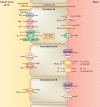Differential diagnosis of perinatal Bartter, Bartter and Gitelman syndromes
- PMID: 33564404
- PMCID: PMC7857843
- DOI: 10.1093/ckj/sfaa172
Differential diagnosis of perinatal Bartter, Bartter and Gitelman syndromes
Erratum in
-
Erratum: Differential diagnosis of perinatal Bartter, Bartter and Gitelman syndromes.Clin Kidney J. 2021 Jan 9;14(4):1296. doi: 10.1093/ckj/sfaa243. eCollection 2021 Apr. Clin Kidney J. 2021. PMID: 33841877 Free PMC article.
Abstract
The common finding of hypokalemic alkalosis in several unrelated disorders may confound the early diagnosis of salt-losing tubulopathy (SLT). Antenatal Bartter syndrome (BS) must be considered in idiopathic early-onset polyhydramnios. Fetal megabladder in BS may allow its distinction from third-trimester polyhydramnios that occurs in congenital chloride diarrhea (CCD). Fetal megacolon occurs in CCD while fecal chloride >90 mEq/L in infants is diagnostic. Failure-to-thrive, polydipsia and polyuria in early childhood are the hallmarks of classic BS. Unlike BS, there is low urinary chloride in hypokalemic alkalosis of intractable emesis and cystic fibrosis. Rarely, renal salt wasting may result from cystinosis, Dent disease, disorders of paracellular claudin-10b and Kir4.1 potassium-channel deficiency. Acquired BS may result from calcimimetic up-regulation of a calcium-sensing receptor or autoantibody inactivation of sodium chloride co-transporters in Sjögren syndrome. A relatively common event of heterozygous gene mutations for Gitelman syndrome increases the likelihood of its random occurrence in certain diseases of adult onset. Finally, diuretic abuse is the most common differential diagnosis of SLT. Unlike the persistent elevation in BS, urinary chloride concentration losses waxes and wanes on day-to-day assessment in patients with diuretic misuse.
Keywords: Gitelman; acquired Bartter; antenatal Bartter; hypochloremic metabolic alkalosis; pseudo-Bartter syndromes.
© The Author(s) 2020. Published by Oxford University Press on behalf of ERA-EDTA.
Figures




Similar articles
-
Bartter Syndrome and Gitelman Syndrome.Pediatr Clin North Am. 2019 Feb;66(1):121-134. doi: 10.1016/j.pcl.2018.08.010. Pediatr Clin North Am. 2019. PMID: 30454738 Review.
-
Inherited salt-losing tubulopathy: An old condition but a new category of tubulopathy.Pediatr Int. 2020 Apr;62(4):428-437. doi: 10.1111/ped.14089. Epub 2020 Apr 13. Pediatr Int. 2020. PMID: 31830341 Review.
-
The utility of next generation sequencing in the correct diagnosis of congenital hypochloremic hypokalemic metabolic alkalosis.Eur J Med Genet. 2019 Oct;62(10):103728. doi: 10.1016/j.ejmg.2019.103728. Epub 2019 Jul 17. Eur J Med Genet. 2019. PMID: 31325522
-
A novel homozygous CLCNKB variant: An early presentation of classic Bartter syndrome in a neonate.Birth Defects Res. 2023 Oct 15;115(17):1674-1679. doi: 10.1002/bdr2.2235. Epub 2023 Aug 16. Birth Defects Res. 2023. PMID: 37587715
-
Use of calcium excretion values to distinguish two forms of primary renal tubular hypokalemic alkalosis: Bartter and Gitelman syndromes.J Pediatr. 1992 Jan;120(1):38-43. doi: 10.1016/s0022-3476(05)80594-3. J Pediatr. 1992. PMID: 1731022
Cited by
-
Molecular Basis, Diagnostic Challenges and Therapeutic Approaches of Bartter and Gitelman Syndromes: A Primer for Clinicians.Int J Mol Sci. 2021 Oct 22;22(21):11414. doi: 10.3390/ijms222111414. Int J Mol Sci. 2021. PMID: 34768847 Free PMC article. Review.
-
The term CAKUT has outlived its usefulness: the case for the prosecution.Pediatr Nephrol. 2022 Nov;37(11):2785-2791. doi: 10.1007/s00467-022-05576-4. Epub 2022 May 16. Pediatr Nephrol. 2022. PMID: 35575937 Free PMC article. Review.
-
Genetic background of neonatal hypokalemia.Pediatr Nephrol. 2025 Feb;40(2):301-317. doi: 10.1007/s00467-024-06492-5. Epub 2024 Sep 16. Pediatr Nephrol. 2025. PMID: 39283520 Review.
-
Animal, Human, and 23Na MRI Imaging Evidence for the Negative Impact of High Dietary Salt in Children.Curr Pediatr Rep. 2021;9(4):110-117. doi: 10.1007/s40124-021-00249-6. Epub 2021 Sep 18. Curr Pediatr Rep. 2021. PMID: 34567839 Free PMC article. Review.
-
Application of low-vacuum scanning electron microscopy and energy-dispersive X-ray spectrometry for detection of renal tubular crystals: a case of nephrocalcinosis in the setting of anorexia nervosa.BMC Nephrol. 2025 Jul 4;26(1):352. doi: 10.1186/s12882-025-04287-w. BMC Nephrol. 2025. PMID: 40615991 Free PMC article.
References
-
- Simon DB, Lifton RP.. The molecular basis of inherited hypokalemic alkalosis: Bartter’s and Gitelman’s syndromes. Am J Physiol 1996; 271: F961–F966 - PubMed
-
- Seyberth HR. W, Koniger SJ, Rascher W. et al. Role of prostaglandins in hyperprostaglandin E syndrome and in selected renal tubular disorders. Pediatr Nephrol 1987; 1: 491–497 - PubMed
-
- Blanchard A, Bockenhauer D, Bolignano D. et al. Gitelman syndrome: consensus and guidance from a Kidney Disease: Improving Global Outcomes (KDIGO) controversies conference. Kidney Int 2017; 91: 24–33 - PubMed
-
- Seyberth HW, Weber S, Kömhoff M.. Bartter’s and Gitelman’s syndrome. Curr Opin Pediatr 2017; 29: 179–186 - PubMed
Publication types
LinkOut - more resources
Full Text Sources

